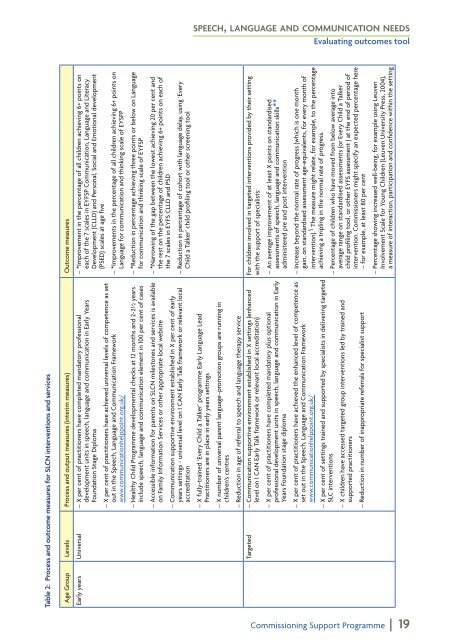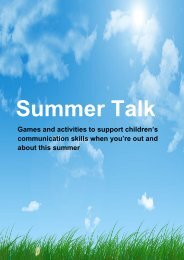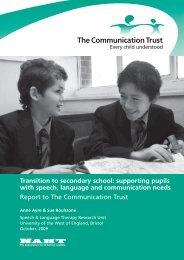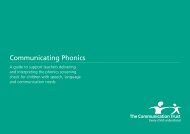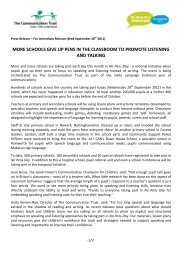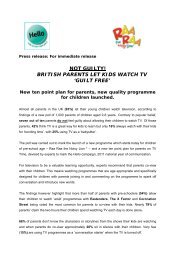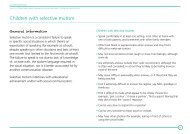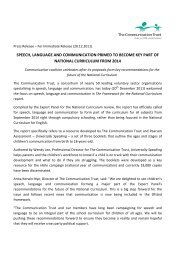Speech, language and communication needs: Evaluating outcomes ...
Speech, language and communication needs: Evaluating outcomes ...
Speech, language and communication needs: Evaluating outcomes ...
Create successful ePaper yourself
Turn your PDF publications into a flip-book with our unique Google optimized e-Paper software.
speech, <strong>language</strong> <strong>and</strong> <strong>communication</strong> <strong>needs</strong><br />
<strong>Evaluating</strong> <strong>outcomes</strong> tool<br />
Table 2: Process <strong>and</strong> outcome measures for SLCN interventions <strong>and</strong> services<br />
Age Group Levels Process <strong>and</strong> output measures (interim measures) Outcome measures<br />
Early years Universal – – X per cent of practitioners have completed m<strong>and</strong>atory professional<br />
development units in speech, <strong>language</strong> <strong>and</strong> <strong>communication</strong> in Early Years<br />
Foundation Stage Diploma<br />
– – X per cent of practitioners have achieved universal levels of competence as set<br />
out in the <strong>Speech</strong>, Language <strong>and</strong> Communication Framework<br />
www.<strong>communication</strong>helppoint.org.uk/<br />
– – *Improvement in the percentage of all children achieving 6+ points on<br />
each of the 7 scales in EYFSP Communication, Language <strong>and</strong> Literacy<br />
Development (CLLD) <strong>and</strong> Personal, Social <strong>and</strong> Emotional development<br />
(PSED) scales at age five<br />
– – *Improvements in the percentage of all children achieving 6+ points on<br />
Language for <strong>communication</strong> <strong>and</strong> thinking scale of EYSFP<br />
– – Healthy Child Programme developmental checks at 12 months <strong>and</strong> 2-2½ years<br />
include speech, <strong>language</strong> <strong>and</strong> <strong>communication</strong> element in 100 per cent of cases<br />
– – *Reduction in percentage achieving three points or below on Language<br />
for <strong>communication</strong> <strong>and</strong> thinking scale of EYFSP<br />
– – Accessible information for parents on SLCN milestones <strong>and</strong> services is available<br />
on Family Information Services or other appropriate local website<br />
– – Communication supportive environment established in X per cent of early<br />
years settings - universal level on I CAN Early Talk framework or relevant local<br />
accreditation<br />
– – *Narrowing of the gap between the lowest achieving 20 per cent <strong>and</strong><br />
the rest on the percentage of children achieving 6+ points on each of<br />
the 7 scales in EYFS CLLD <strong>and</strong> PSD<br />
– – Reduction in percentage of cohort with <strong>language</strong> delay, using ‘Every<br />
Child a Talker’ child profiling tool or other screening tool<br />
– – X fully-trained ‘Every Child a Talker’ programme Early Language Lead<br />
Practitioners are in place in early years settings<br />
– – X number of universal parent <strong>language</strong>–promotion groups are running in<br />
children’s centres<br />
– – Reduction in age of referral to speech <strong>and</strong> <strong>language</strong> therapy service<br />
Targeted – – Communication supportive environment established in X settings (enhanced<br />
level on I CAN Early Talk framework or relevant local accreditation)<br />
– – X per cent of practitioners have completed m<strong>and</strong>atory plus optional<br />
professional development units in speech, <strong>language</strong> <strong>and</strong> <strong>communication</strong> in Early<br />
Years Foundation stage diploma<br />
– – X per cent of practitioners have achieved the enhanced level of competence as<br />
set out in the <strong>Speech</strong>, Language <strong>and</strong> Communication Framework<br />
www.<strong>communication</strong>helppoint.org.uk/<br />
– – X per cent of settings trained <strong>and</strong> supported by specialists in delivering targeted<br />
SLC interventions<br />
– – X children have accessed targeted group interventions led by trained <strong>and</strong><br />
supported practitioners<br />
– – Reduction in number of inappropriate referrals for specialist support<br />
For children involved in targeted interventions provided by their setting<br />
with the support of specialists:<br />
– – An average improvement of at least X points on st<strong>and</strong>ardised<br />
assessments of speech, <strong>language</strong> <strong>and</strong> <strong>communication</strong> skills**<br />
administered pre <strong>and</strong> post intervention<br />
– – Increase beyond the normal rate of progress (which is one month<br />
gain, on st<strong>and</strong>ardised assessment age-equivalents, for every month of<br />
intervention). § The measure might relate, for example, to the percentage<br />
achieving a tripling in the normal rate of progress.<br />
– – Percentage of children who have moved from below average into<br />
average range on st<strong>and</strong>ardised assessments (or Every Child a Talker<br />
child profiling tool, or other EYFS assessment ) at the end of period of<br />
intervention. Commissioners might specify an expected percentage here<br />
– for example, at least 80 per cent<br />
– – Percentage showing increased well-being, for example using Leuven<br />
Involvement Scale for Young Children (Leuven University Press, 2004),<br />
a measure of interaction, participation <strong>and</strong> confidence within the setting<br />
Commissioning Support Programme | 19


